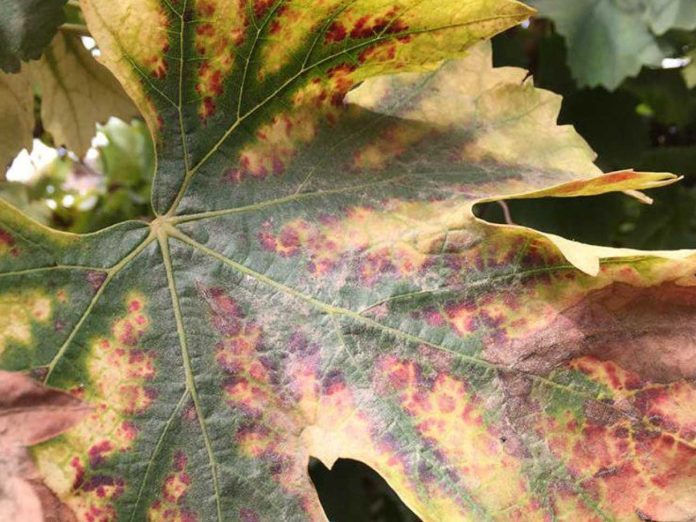When most California grape growers think of macronutrients, nitrogen (N) and potassium (K) are rightfully at the top of list, as these two mineral nutrients are needed in relatively high amounts and are commonly supplemented with fertilizer applications. However, magnesium (Mg) is also considered a macronutrient, though it is needed in much lower amounts than N or K. Even so, it is not uncommon to observe Mg deficiency symptoms, especially in certain grape varieties which appear to be particularly prone to Mg deficiency, including Barbera, Grenache, Redglobe, Thompson Seedless, and Zinfandel. Recently, I have heard from several growers that some of the newer table and raisin grape varieties also appear to be prone to Mg deficiency. Rootstocks also differ in their ability to take up Mg. For example, 1103P is considered to be good at amassing Mg, whereas Riparia Gloire (Vitis riparia), and some V. riparia hybrid stocks are less effective at amassing Mg.
Magnesium
Magnesium is a central component of chlorophyll, and by mid to late summer, the leaves of Mg-deficient vines typically develop a distinctive creamy-white chlorosis along the margin of basal leaves. The primary and secondary veins of the leaves retain a dark green color, resulting in a Christmas-tree pattern on the leaf (Figure 1). In red varieties, the leaf margins may develop red color (Figure 1), and in severe deficiencies, the margin may become necrotic, brown colored, and dry. Analysis of petiole samples can be useful in verifying Mg deficiency. Petioles collected at bloom should contain >0.3 percent Mg.
Magnesium plays a critical role in enzymatic reactions, including the activation of adenosine triphosphate (ATP). Magnesium deficiency impairs the loading of sucrose into phloem in leaves, thereby causing carbohydrates to accumulate in leaves, while reducing the supply of carbohydrates to other organs that need them. Thus, Mg deficiency could theoretically limit the vine’s ability to produce and distribute carbohydrates. Australian research has linked low Mg levels in rachises with bunch stem necrosis (BSN), and in such cases, application of Mg reduced BSN. Vines with Mg-associated BSN sometimes, but not always, had leaves with Mg deficiency symptoms. However, studies in California have not verified a link to Mg and BSN.
Magnesium is Moderately Leachable in Soil
Magnesium is moderately leachable in soil and tends to be most abundant in subsoil and least abundant in the surface layers, especially on weathered soils. Young vines are more susceptible to Mg deficiency than older vines, probably because the roots of young vines have likely not explored as much of the subsoil as the roots of older vines. Thus, vine age, particularly the age of the root system (if on topworked vines), should be considered when assessing the relatively susceptibility of new varieties to Mg deficiency. Removal with the harvested crop can further reduce Mg in a vineyard, though previous studies suggest that grape berries only amass about 0.2 lbs Mg/ton of fruit. The Mg concentration in soils can be easily measured, but critical soil values have not been established, and it would be very difficult to account for the possible supply of Mg in the subsoil that may be available to the vine.
As noted above, Mg deficiency can occur due to insufficient Mg in the root zone, a limited root system, or both. However, Mg deficiency can also be induced by soil acidification (pH < 5.5), which can occur after years of irrigation and fertilization. High levels of other cations, especially K and calcium (Ca) compete with Mg for uptake by roots. Thus, an imbalance in K or Ca may induce Mg deficiency. Peacock and Christensen (1996) suggests Mg deficiency is most likely when the Mg saturation of cation exchange capacity of the soil is <5 percent, or when total exchangeable Mg concentration drops below 25 mg/kg. In addition, Peacock and Christensen (1996) notes that exchangeable Mg should be two to three times as high as exchangeable K.
Mild Mg Deficiencies
Mild Mg deficiencies, defined as the appearance of symptoms on a few basal leaves in localized vineyard areas, do not contribute to economic loss, and do not require correction. More serious deficiencies should be corrected. To correct Mg deficiencies, growers should consider the various factors, outlined above, which can contribute to Mg deficiency. For example, if soil acidification is found to be a contributing factor, then incorporating lime into the soil can help address Mg deficiency. Dolomitic limestone can increase pH and add Mg. Fertigation and foliar application of Mg fertilizers are effective and may be needed in cases where the deficiency is due to insufficient Mg in soil. Magnesium sulfate may be used for either fertilization method, though other Mg fertilizers are also available. Christensen and Peacock recommended ½ to 2 lbs of MgSO4/vine for fertigation, and 4 lbs MGSO4/100 gallons for foliar application.
Further Reading:
Christensen, L.P. and W.L. Peacock. 2000. Mineral nutrition and fertilization. In Raisin Production Manual. L.P. Christensen (Ed.), pp. 102-114. University of California Agriculture and Natural Resources, Oakland.
Peacock, B. and P. Christensen. 1996. Magnesium deficiency becoming more common. UCCE Pub. NG5-96

















